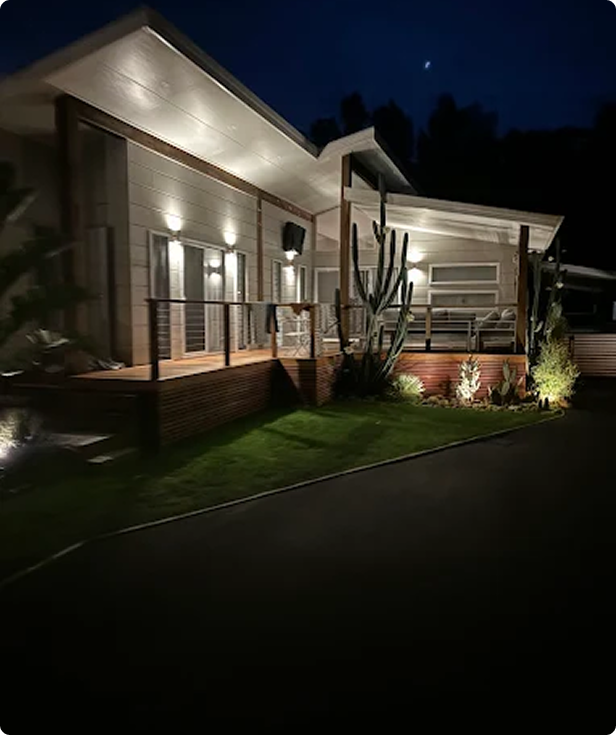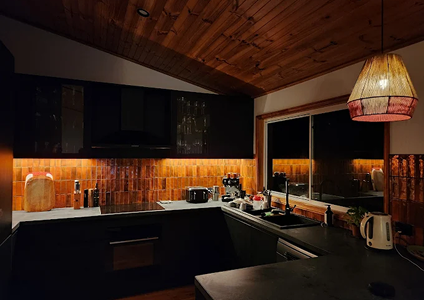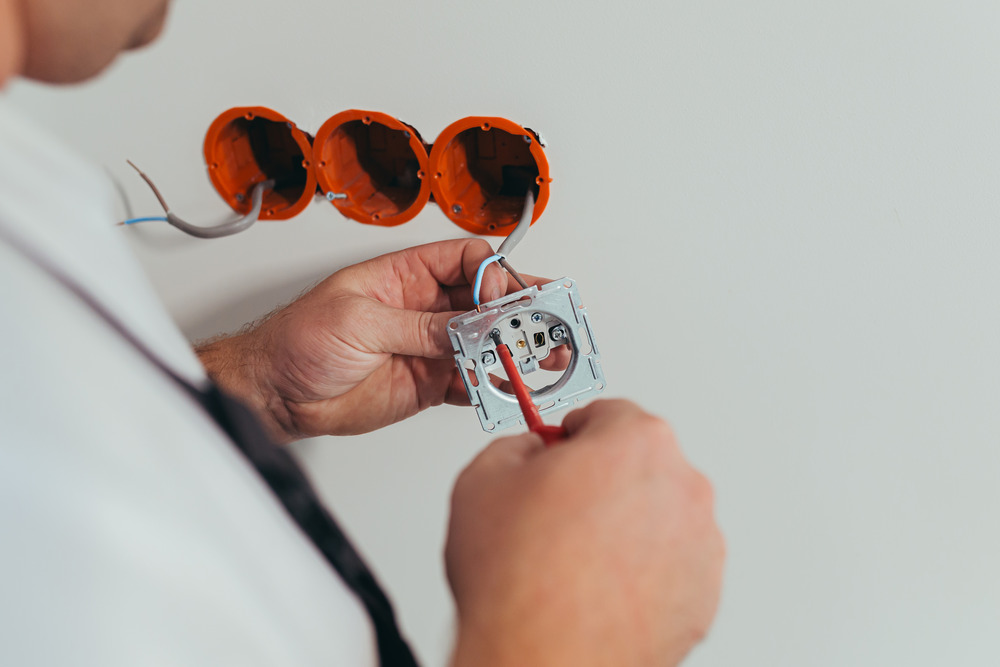Realise the importance of lighting
Outdoor security lights help protect your property by making it less inviting for trespassers and giving you a clear view of any activity outside. In a 2024 Australian safety survey, over 65% of participants said that proper exterior lighting lowered their fear of nighttime intrusions. Beyond safety, having well-positioned lights can prevent everyday slips and falls on walkways or driveways in the dark. That means more peace of mind for you, your family, and any visitors arriving after sundown.
A proven crime deterrent
Good news, research shows that criminals are far less likely to target brightly lit homes than dimly lit ones, especially when motion sensors are in play. Burglars often prefer an easy path where they can stay hidden. By illuminating vulnerable spots, you reduce those hiding places, lower potential risks, and send a clear message that your property is watched and maintained. If you’d like a deeper dive into the rationale behind this, see the importance of security lighting to discover how it can impact safety on a broader scale.

Everyday benefits
While preventing crime often tops the list, outdoor security lights offer everyday convenience too. For instance:
- Lighting up your driveway so you can safely park at night
- Guiding your path from the car to the front door without fumbling for the porch light
- Showing off your garden or patio area, making outdoor gatherings more inviting
These lights can also boost your property’s curb appeal. A well-placed fixture highlights attractive features like flowerbeds or neat walkways, making your home more pleasant after sundown.
Compare main security light types
Not all outdoor security lights are created equal. Different models have distinct features, capabilities, and energy requirements. Below is a quick overview of some popular types. Watch for elements like brightness, energy consumption, and coverage area so you can match them to your needs.
| Light Type | Pros | Cons |
|---|---|---|
| LED lighting | Energy-efficient, bright, long-lasting | May need higher initial investment |
| Dusk to dawn fixtures | Automatic function, consistent illumination | Continuous use can increase electricity bills |
| Wireless systems | Flexible placement, no complex wiring | Battery changes or solar reliability can be a concern |
| Motion sensors | Activates only when movement is detected, saves power | Requires careful positioning to avoid false triggers |
LED lighting
You can’t go wrong with LED security lights if you want bright illumination without high electricity bills. LEDs use a fraction of the energy of older incandescent bulbs and can last for years. That reliability makes them a solid choice in Australian climates, where temperatures can sometimes drop or spike. If you’re interested in going greener, check out energy-efficient security lighting for tips on choosing eco-friendly fixtures.
Dusk to dawn fixtures
If you prefer a set-and-forget style, dusk to dawn lights might be your solution. They turn on automatically at sunset and switch off at sunrise. In New South Wales, streetlights often follow a similar schedule, so you enjoy a consistent light source during the dark hours. While they do consume energy all night, many newer models use LED bulbs to offset those running costs. Appropriate for entries, gardens, or even driveway security lighting if you want continual illumination during the wee hours.
Wireless systems
For areas where cables are impractical, wireless options are a handy alternative. Solar-powered variants can harvest energy during the day, while battery-powered versions are a fallback if your site lacks sunlight or easy electrical access. Keep an eye on the location, ensuring your lights receive sufficient daylight if you choose solar. Regularly check battery levels so your security coverage doesn’t fail at a critical moment. Some homeowners find these perfect for tight spots like side passages or sheds.
Motion sensors
Motion sensor lights activate only when they detect movement, acting as a strong deterrent and saving energy. When they switch on suddenly, potential intruders are often startled or exposed. The key to success is positioning the sensor so you cover likely approaches without triggering frequent false alarms from passing cars or swaying trees. If you want to reduce wasted light and ensure instant illumination when you step outside, a motion-based system could be your best bet.
Position them effectively
Selecting the right light model is only half the battle. Proper positioning ensures you cover vulnerable spots while keeping glare and light pollution to a minimum. Focus on entryways, driveways, garages, gardens, and any side passages that an intruder might treat as a hidden entry point.
Assess your property layout
Walk around your home at night and note dim corners or paths that feel less secure. Look for:
- Dark nooks where lighting from the street doesn’t reach
- Overgrown landscaping that could hide trespassers
- Areas close to windows or doors where someone could linger unseen
Once you’ve mapped out these weak spots, decide which type of security lighting suits each one. For example, you might use motion-sensor floodlights near the rear door or consider dusk to dawn security lights for a front porch that requires consistent illumination.
Focus on key zones
Every property is unique, but certain areas typically require extra attention:
Driveways, gardens, and parking spaces
Your driveway often serves as the main approach to your home. Adding focused, wide-angle beams here can help you park safely and deter prowlers. To explore more about how to secure that space, visit driveway security lighting. If you’re proud of your outdoor foliage or have a shared courtyard, consider garden security lighting or security lighting for parking lots. These solutions ensure that large or communal areas also remain well-lit, reducing accidents and hidden corners.
Front and back doors
Front doors often act as the most prominent target for potential intruders. Installing a beam overhead or near the door helps you identify visitors, whether expected or unwelcome. Back doors or side entries can remain out of sight from the street. Motion-activated lights here can catch somebody off guard. Make sure the lights are high enough to discourage tampering.
Pathways and fences
Pathway lighting is key for nightly comfort. You’ll avoid tripping hazards and keep the approach visible for guests. If you have a fenced perimeter, consider adding smaller fixtures at intervals, especially near gates or corners. This approach helps you see anybody approaching from the perimeter before they reach your home.
Install with confidence
Fitting outdoor security lights can be straightforward, but safety always comes first. Faulty wiring or incorrect fixture placement can cause electric hazards or reduce your lighting coverage. Taking a careful, step-by-step approach will keep everything in check.
DIY considerations
You may handle some simple outside lighting projects on your own if you have basic electrical knowledge and the right tools. However, you must always turn off power at the circuit breaker before starting any work. It’s often wise to stick to small tasks like swapping an existing light fixture. For more complex projects requiring new wiring or multiple fixtures, your local regulations might require a licensed electrician’s expertise. If you plan on installing many lights and want long-term reliability, talk to a professional or read into security lighting installation to learn the recommended best practices.
Professional insights
Hiring a certified electrician often saves you time, meets council requirements, and ensures your warranties remain valid. Pros are well-versed in local guidelines, so they’ll keep your connections compliant. They can also advise on advanced setups like wireless security lighting or layered lighting systems that combine motion sensors, timers, and manual switches. Plus, professionals frequently use high-quality brackets, weatherproof enclosures, and the right cables to withstand Australian conditions.
Maintain your system
Once your lights are in place, ongoing care is essential to keep everything working reliably. Changing a bulb or adjusting an angle might not seem urgent, but a small oversight can leave you in the dark when you need light the most.
Regular checks
Perform a quick inspection every month:
- Make sure bulbs are functioning and not flickering
- Wipe away dirt or cobwebs so sensors remain clear
- Adjust angles if nearby shrubbery grows or if something blocks the beam
Plan an annual or bi-annual deep clean, removing any built-up grime on lenses or solar panels (if applicable). This pays off by keeping your brightness levels optimal.
When to upgrade
Even the best lighting systems age over time. Some older halogen or fluorescent fixtures guzzle energy compared to LED versions. If your lights repeatedly fail, it might be time to invest in new technology. Modern systems often let you fine-tune brightness levels or schedules through a mobile app. It’s worth checking if an advanced motion sensor or an entire overhaul to energy-efficient security lighting might cut power bills while giving you better coverage.
Also, keep an eye out for local council updates on recommended or required standards. Technology evolves fast, and you might discover cost-friendly alternatives that deliver more targeted illumination. An occasional check-in with a professional can point you in the right direction, especially if you have a big property with multiple zones.
Recap and next step
Outdoor security lights can give you real peace of mind, reduce trespassing, and highlight important features around your home. Here’s a quick summary of your ideal strategy:
- Consider which light types suit your space, such as LED lighting or wireless security lighting.
- Identify dark corners, driveways, and gardens that need illumination. Visit garden security lighting or driveway security lighting for more targeted insights.
- Use motion sensors or dusk to dawn fixtures in high-risk areas for maximum impact.
- Follow best practices for installation, or consult a licensed electrician to stay compliant with local codes.
- Keep up with routine maintenance. Look out for flickering bulbs or unclear sensors.
- Upgrade if your current system becomes outdated or if you want advanced features like app-based controls.
If you would like expert help with your next lighting project, ABC Electrical & Property Maintenance offers professional security lighting solutions across the Central Coast. From planning the layout to ensuring your setup meets council standards, they can guide you through every step. You’ll enjoy reliable results, and your property will feel safer the moment dusk sets in.
Good news, all these steps are easier than they might sound. By choosing dependable outdoor security lights and positioning them strategically, you’ll strengthen your property’s defences and gain more comfort after sundown. The results speak for themselves, so take the next step today and enjoy enhanced security for years to come.



